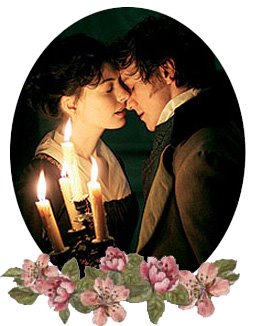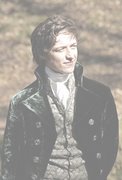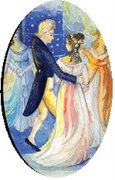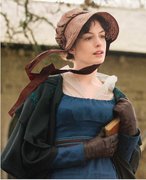Dressing Jane: About the Costumes
This time, I copy an article from the U.S. about the costume. I’m happy to see that quite a few of my earlier observations in the female and male costumes were correct (including Tom's white coat referring to Jane's letters on January 9 and 16, 1796). But of course, this article gives more info than what I have excavated. See the U.S. Official Site, under the ‘About the movie’ and ‘Production Notes’ for ‘Dressing Jane’. I've said it, and I will say it again: this movie deserves an Oscar for costume design!
As with the photography and production design, Julian Jarrold hoped to take a different view of Austen-era costumes in BECOMING JANE. For this, he worked with Emmy-nominated Irish costume designer Eimer Ní Mhaoldomhnaigh ("David Copperfield," THE WIND THAT SHAKES THE BARLEY).
"Like most people I studied Jane Austen at school so I was familiar with her world," says Ní Mhaoldomhnaigh. "But I deliberately moved away from recent film adaptations of Jane Austen's work and my priority was to try to do something different. 1790s Regency England was a very transitional era in terms of fashion so it was a real challenge to make it work."
Ní Mhaoldomhnaigh read up on the fashion of the day, visited museums for inspiration, consulted Austen's letters for clues and reread the novels for context and color. In particular she investigated the influence of continental fashions and also the likely differences not only between town (
By the mid-1790s, Ní Mhaoldomhnaigh also learned, fashion was becoming simpler, moving away from the huge dresses of the French Revolution and towards a more modern look. "Things were heading towards the Empire line which is a very basic style influenced by the Roman and Greek civilizations," she says. "1795 marked the beginning of that trend. But because Jane Austen was from the country which is slower to adapt to fashion changes we are showing just the introduction of that. The look in
Ní Mhaoldomhnaigh sourced authentic fabric in
It didn't hurt that Ní Mhaoldomhnaigh was dressing the preternaturally lovely Anne Hathaway, who became a close collaborator in the creation of her character's costumes. "It was great to dress Annie," the designer says. "She had just come from THE DEVIL WEARS PRADA, in which she wore all this amazing couture fashion and now I had to talk to her about wearing simple cotton dresses! But she was very keen to get the details right. Sometimes I would suggest a little extra piece of lace but she would say that it might be too much. She really grasped what we were trying to do. Of course Annie looks so wonderful on camera that she doesn't need adornment."
Meanwhile, Ní Mhaoldomhnaigh focused equally on creating clothes for Tom Lefroy that reveal him as a fashionable man-about-town. The designer was partly inspired by Jane Austen's letter to Cassandra, in which she writes of Lefroy: "He has but one fault, which time will, I trust, entirely remove - it is that his morning coat is a great deal too light. He is a very great admirer of Tom Jones, and therefore wears the same colored clothes."
But she also was influenced by the screenplay's colorful portrait. "When we first meet him, Tom is boxing, boozing and cavorting so there's definitely had to be rakishness to him," says Ní Mhaoldomhnaigh. To make Lefroy stand out from the crowd, Ní Mhaoldhomnaigh used a few tricks of the rag trade. "We used much richer fabrics like velvets," she says. "For his hat we used a beaver fur which is a lot more luxurious than the other hats. He wears very stylish waist coats and cut-away jackets.

With Jane around he'd have an extra swagger in front of her. James was really into it. We'd talk about the colors and fabrics to achieve his distinctive look." Ní Mhaoldhomnaigh notes that men's fashion at the time was also in a state of flux in 1795. "Some of the younger men have cut away style jackets which were just coming into fashion," says Ní Mhaoldomhnaigh. "In the countryside the men were wearing slighter older fashions except for those who had been to
Long trousers did not come into vogue until the early part of the 1800s. Men wore riding boots which were practical but also fashionable. Men's calves were seen as very sexy at the time so if somebody had good calves it was something to be proud of."
 Of the other characters, one of the most distinctive is Maggie Smith's Lady Gresham. "I spoke with Maggie and told her that I'd like her costume to be from a slightly earlier period," recalls Ní Mhaoldhomnaigh. "We went for the 1770s, the sort of dress that the Of the other characters, one of the most distinctive is Maggie Smith's Lady Gresham. "I spoke with Maggie and told her that I'd like her costume to be from a slightly earlier period," recalls Ní Mhaoldhomnaigh. "We went for the 1770s, the sort of dress that the character would have worn when she was much younger. Lady Gresham is very much her own character and is not someone who is dictated to by fashion. She looked quite stern, almost gothic so the colors that we choose were greys and sea greens. Everything about her is quite rigid from the skirts to the fabrics. She wears a very large hood called a calash that was very common at the time. No one else in the film is wearing it so it makes her look quite different and even eccentric. Maggie loved it.
Of the other characters, one of the most distinctive is Maggie Smith's Lady Gresham. "I spoke with Maggie and told her that I'd like her costume to be from a slightly earlier period," recalls Ní Mhaoldhomnaigh. "We went for the 1770s, the sort of dress that the Of the other characters, one of the most distinctive is Maggie Smith's Lady Gresham. "I spoke with Maggie and told her that I'd like her costume to be from a slightly earlier period," recalls Ní Mhaoldhomnaigh. "We went for the 1770s, the sort of dress that the character would have worn when she was much younger. Lady Gresham is very much her own character and is not someone who is dictated to by fashion. She looked quite stern, almost gothic so the colors that we choose were greys and sea greens. Everything about her is quite rigid from the skirts to the fabrics. She wears a very large hood called a calash that was very common at the time. No one else in the film is wearing it so it makes her look quite different and even eccentric. Maggie loved it.
Not so enjoyable were the corsets -- de rigueur in Regency England but the bane of the 21st Century actors' lives. "Having to put on the corsets, especially first thing in the morning, they would say, ‘Oh do I have to?’" recalls Ní Mhaoldomhnaigh. "But that's how you get the distinctive look and silhouette of the period."
Pic 1,2 and 5: www.annie-hathaway.com
Pic 3 and 4: www.james-mcavoy.net















































4 comments:
Are you insane!? The costume design drives me nuts in this film! all over the map. I was cringing the whole time. Study the era before you slap gowns on people willy nilly 20 years one way and the other.
I find it interesting that people can forget manners when voicing their opinions. Yes, now we understand that some costumes were not perfect, but they are still beautiful nonetheless. Regardless of that, your manner, Madame, in voicing your opinion here is totally unwelcome. I can take that people disagree at times, but rudeness should not stand next to logic and the spirit of discussion.
This discussion led me to do some research that I had wanted to do – about LADIES FASHIONS.
First, it was necessary to watch the film “Becoming Jane” again to take notice of the fashions. In recent years I have wanted to make some Ladies Fashions for “Ladies” as compared to “sluts and whores” etc – if you get my drift. The Ladies should be the EQUAL (but not the same) of GENTLEMEN when it comes to clothes.
Second, I researched the book I had of my home town in the 1900s where the “Ladies” were always “covered” from neck to toe. When I found that book, I was taken completely by surprise when I discovered several other books that I had collected from exhibits of Napoleon, etc. So I had quite an excursion into the Jane Austen era.
Third, Lo and Behold! I found that the movie was correct in depicting the costumes with low bodice fronts and backs, etc. So now I really must begin my “House of Ladies Fashions”!
So, in my opinion Woman Scorned is wrong because the gowns do fit the era. I find that the costumes are correct for the era, whether I like them or not.
Yrs aff’ly,
Linda the Librarian
I will leave this here which describes how the costuming was all over the map. Yes, it was a transitional period in the 1790s, but this was mostly a mash up, not a transitional period. A lot of things are wrong, but some things are very right.
https://www.frockflicks.com/becoming-jane/
Post a Comment